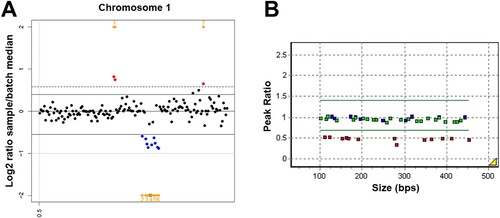Figures & data
Table 1. Results of laboratory blood analyses in a Korean patient with atypical hemolytic uremic syndrome.
Figure 1. The heterozygous CFHR3/CFHR1 deletion identified by copy number variation (CNV) analysis using next-generation sequencing and multiplex ligation-dependent probe amplification (MLPA) in a patient with atypical hemolytic uremic syndrome. (A) CNV detection tool identifies a heterozygous partial deletion of chromosome 1q31.3, including a region from the CFHR3 and the CFHR1 genes, with a Z ratio between −0.5 and −1. (B) MLPA demonstrates a heterozygous deletion between the CFHR3 (NM_021023.5; 5UTR, exon 1, exon 2, exon 3, intron 4, and exon 6) and the CFHR1 (NM_002113.2; intron1, intron 3, exon5, and exon 6) genes on chromosome 1q31.3 in the patient.

